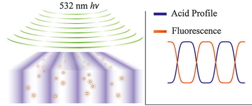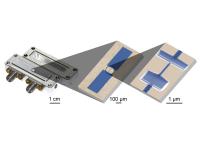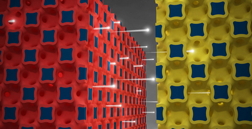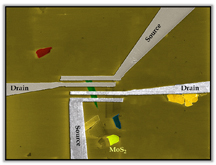Science
SN 1006: X-Ray View of A Thousand-Year-Old Cosmic Tapestry

.A new Chandra image of SN 1006 provides new details about
the remains of an exploded star.
.This explosion was witnessed from Earth over a millennium
ago.
.The Chandra data provides the best map to date of the
debris field including information on important elements
expanding into space.
.SN 1006 belongs to a class of supernova used to measure
the expansion of the Universe.
- Read more
- 305 reads
Star factory in the early Universe challenges galaxy evolution theory

Starburst galaxy
- Read more
- 348 reads
Fluorescence Technique Measures Photoacid Distribution in Photoresists with Nanoscale Resolution

Schematic showing fluorescence from UV-activated fluorophores excited by 532 nm light that reveals nanoscale photoacid distribution (left). Activated fluorophore concentration corresponds to the inverse of the original photoacid distribution (right).
- Read more
- 354 reads
A new twist for quantum systems

Macroscopic quantum objects: A microwave resonator measuring 32 mm x 15 mm x 5 mm (left) contains superconducting circuits (center and right) that display similar quantum behavior as atoms.
- Read more
- 377 reads
NASA’s Wind Mission Encounters ‘SLAMS’ Waves

Earth is surrounded by a giant magnetic bubble called the magnetosphere. As it travels through space, a complex system of charged particles from the sun and magnetic structures piles up in front of it. Scientists wish to better understand this area in front of the bow shock, known as the foreshock, as it can help explain how energy from the rest of space makes its way past this boundary into the magnetosphere.
- Read more
- 355 reads
How to Target an Asteroid

This spectacular image of comet Tempel 1 was taken 67 seconds after it obliterated Deep Impact's impactor spacecraft.
- Read more
- 332 reads
Small in size, big on power: New microbatteries a boost for electronics

The graphic illustrates a high power battery technology from the University of Illinois. Ions flow between three-dimensional micro-electrodes in a lithium ion battery.
- Read more
- 421 reads
From solar activity to stunning aurora

This beautiful aurora illuminates the sky over the snow-clad landscape near Tromsø, Norway.
- Read more
- 314 reads
Layered '2-D nanocrystals' promising new semiconductor

Researchers are developing a new type of semiconductor technology, pictured here, for future computers and electronics based on "two-dimensional nanocrystals." The material is layered in sheets less than a nanometer thick that could replace today's silicon transistors.
- Read more
- 338 reads
Human Rights
Fostering a More Humane World: The 28th Eurasian Economic Summi

Conscience, Hope, and Action: Keys to Global Peace and Sustainability

Ringing FOWPAL’s Peace Bell for the World:Nobel Peace Prize Laureates’ Visions and Actions

Protecting the World’s Cultural Diversity for a Sustainable Future

Puppet Show I International Friendship Day 2020


